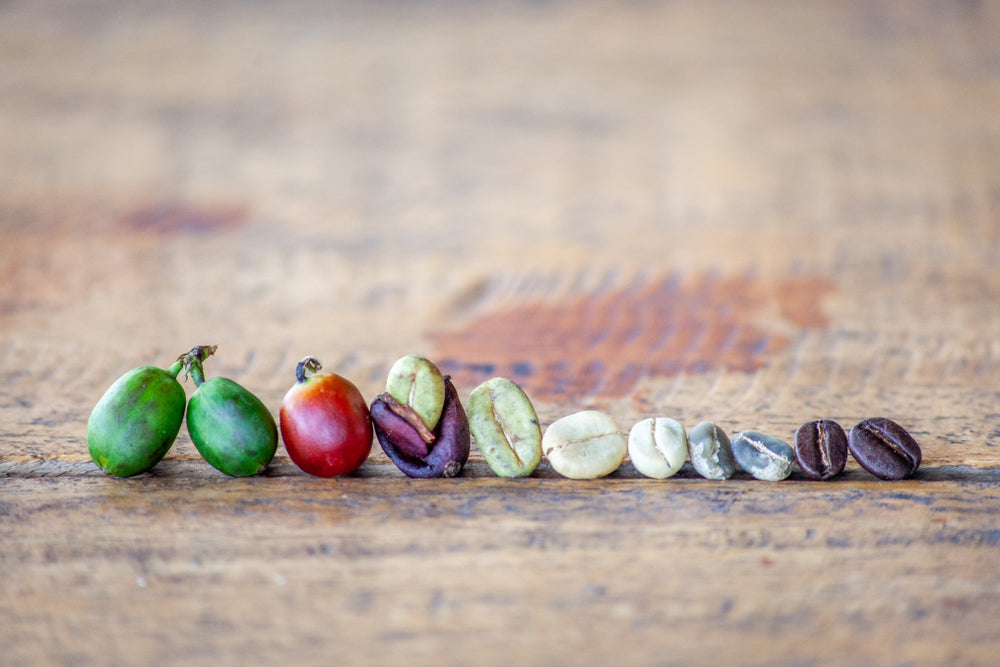Add description, images, menus and links to your mega menu
A column with no settings can be used as a spacer
Link to your collections, sales and even external links
Add up to five columns
Add description, images, menus and links to your mega menu
A column with no settings can be used as a spacer
Link to your collections, sales and even external links
Add up to five columns

The Ultimate Guide to Coffee and Roast
April 09, 2025 3 min read
The Ultimate Guide to Coffee and Roast: Light, Medium & Dark Explained
If you’ve ever stood in the coffee aisle wondering whether to go with a light, medium, or dark roast, you’re not alone. The roast level has a huge impact on how your coffee tastes—arguably more than anything else. In this guide, we’ll break down everything you need to know about coffee and roast so you can find your perfect cup.
What Is Coffee Roasting and Why It Matters
Coffee beans start out as green, raw seeds with very little flavor. It’s not until they’re roasted that their full potential is unlocked.
Roasting is where the magic happens. When heat is applied to green coffee beans, complex chemical reactions occur, including the Maillard reaction, which creates the rich aromas, deep flavors, and bold body we associate with a great cup of coffee. While the origin and processing of a bean matter, the roast level plays the biggest role in how your coffee ultimately tastes.
The Three Main Types of Coffee Roasts
Most coffees fall into one of three main roast categories:
Light Roast Coffee
- Color: Light brown
- Flavor: Bright, fruity, floral, acidic
- Body: Light
- Best For: Pour over, Chemex, AeroPress
- Notes: Retains more of the bean’s original characteristics and origin flavors.
Medium Roast Coffee
- Color: Medium brown
- Flavor: Balanced, sweet, toasty, fruity
- Body: Medium
- Best For: Drip coffee, cold brew, French press
- Notes: A crowd-pleaser with mellow acidity and smooth character.
Dark Roast Coffee
- Color: Dark brown to nearly black
- Flavor: Bold, bittersweet, chocolatey, smoky
- Body: Full-bodied
- Best For: Espresso, French press
- Notes: Caramelized sugars, oils on the bean surface, robust flavor.
Understanding Coffee Roast Levels and Flavor Profiles
Roast level doesn’t just change the color of the bean—it transforms aroma, flavor, body, and even mouthfeel. Here’s a deeper look:
|
Roast Level |
Description |
Flavor Profile |
|
Under-Roasted |
Pale green, grassy aroma |
Weak, sour, undeveloped |
|
Light Roast |
Light brown, matte finish |
Tart, citrus, tea-like |
|
Medium Roast |
Medium brown, slightly shiny |
Balanced, nutty, sweet |
|
Dark Roast |
Dark brown, oily surface |
Bittersweet, bold, deep cocoa |
|
Extra Dark Roast |
Nearly black, very oily |
Smoky, heavy, brûléed sugar |
|
Over-Roasted |
Charred black, ashy |
Bitter, burnt, metallic |
How Long Does It Take to Roast Coffee?
The typical roasting process depends upon the master coffee roaster, it usually takes 10 to 20 minutes, depending on:
- Type of roasting equipment
- The person or machine roasting the coffee
- Bean density and moisture
- Origin and elevation
Roasting is carefully timed and tracked using what’s called a roast curve—a visual representation of the bean’s temperature over time.
Key Milestones in Roasting:
- First Crack (380–400°F): Beans audibly pop, signaling light roast territory.
- Second Crack (430–450°F): Beans pop again, indicating dark roast development.
Great roasters use all five senses to nail the perfect roast—watching, smelling, listening, and even feeling the beans to assess progress. They aslo look at load size, time, temperature and airflow.
Does Coffee Roast Level Affect Caffeine Content?
Here’s a fun fact: Roast level does not significantly affect caffeine content by weight. But...
- Light roasts are denser because they’ve been roasted for a shorter time.
- Dark roasts are less dense, so by volume (e.g., scoops), light roast has slightly more caffeine.
Pro Tip:
Weigh your coffee for consistent caffeine, no matter the roast level.
Are Coffee Roast Standards the Same Everywhere?
Not exactly. There’s no industry-wide standard for what qualifies as a light, medium, or dark roast.
One company’s medium may be another’s dark. At Weaver’s Coffee & Tea, we don't roast light. Our master coffee roaster, John Weaver was trained by Alfred Peet, the father of Specialty Coffee. We tend to roast on the darker side to bring out natural caramelized sweetness and depth. Our medium roasts are exceptionally balanced, while our dark roasts are bold and smooth crafted with purpose and precision.
Best Brewing Methods for Each Coffee Roast Level
To get the best out of your beans, match the brew method to the roast level:
|
Roast Level |
Best Brewing Methods |
Why It Works |
|
Light Roast |
Pour over, Chemex, AeroPress |
Highlights acidity and floral notes |
|
Medium Roast |
Drip, Cold Brew, French Press |
Balanced, smooth body works in many formats |
|
Dark Roast |
French Press, Espresso |
Brings out bold, chocolatey, and smoky notes |
Final Thoughts: How to Find Your Favorite Coffee and Roast
At the end of the day, coffee and roast come down to personal taste. What matters most is that the coffee is roasted well, regardless of light, medium, or dark.
Try a variety of roasts and brewing methods. Keep notes on what you like. And don’t be afraid to experiment—because discovering your perfect cup is part of the joy of coffee.
☕️ Ready to Explore?
Subscribe
Sign up to get the latest on sales, new releases and more …
